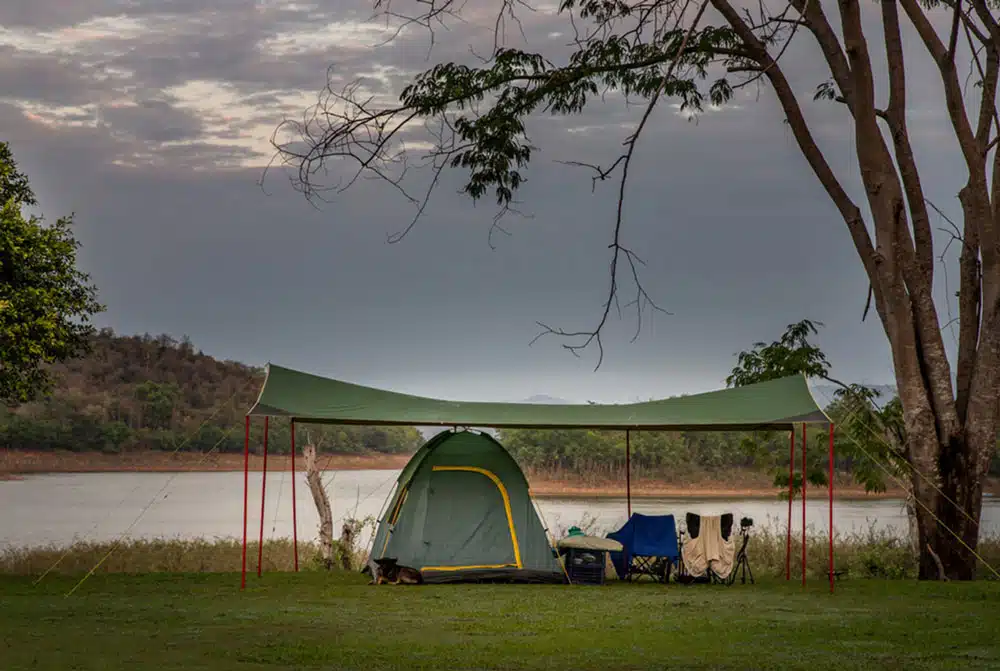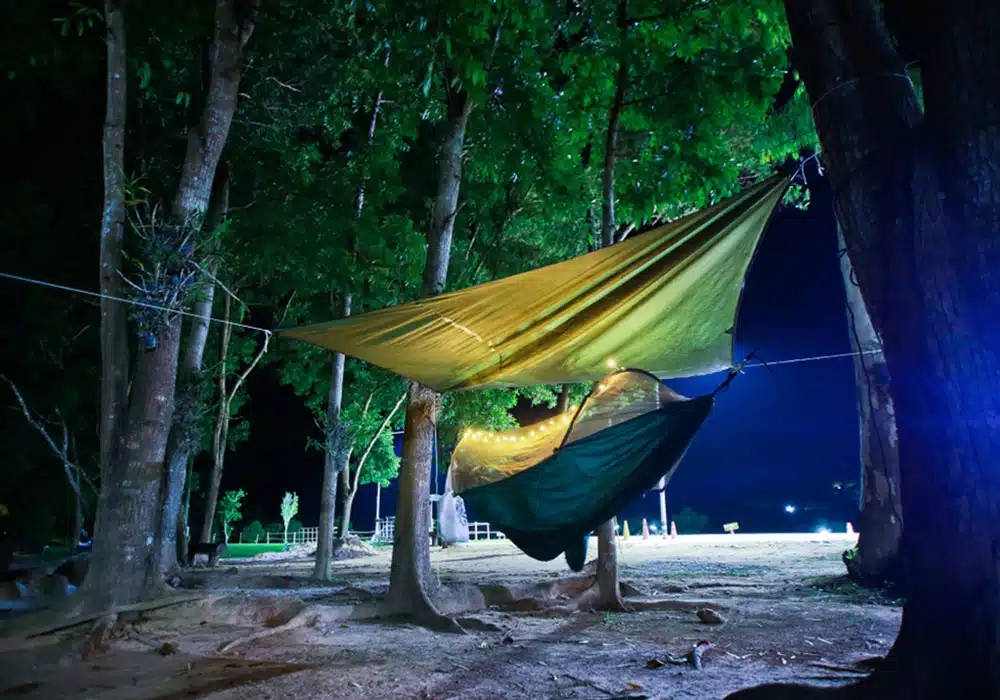Whether you are dry camping in an RV or headed out into the wilderness for a solo adventure, staying hydrated is of absolute importance. This is especially true during the summer months where temps reach 100 degrees July through September. However, as much water as you drink during the day, staying cool at night presents a challenge. With balmy nights, you can sweat out a ton. So, how does one stay cool?
The next time you go camping in the dead heat of summer, remember these tips and tricks. Learning how to stay cool when camping on warm nights can make your experience more enjoyable so you wake up on the right side of the camp pad.
Pack a Frozen Jug of Water
Not only should you pack plenty of water to stay hydrated, but you should also pack a frozen jug of water, too. Why? One of the easiest camping hacks you can do on a warm night is to use the frozen jug as an air conditioner. Placing it at your feet as you sleep is a great way to stay cool. You can also set a portable fan nearby to blow the cool breezes throughout the tent. The next day, you’ll have melted water to drink. Fit a jug inside a spacious rolling cooler with excellent ice retention. But if that’s too big for your trip, you can still freeze a water bottle in a personal cooler, too.
Place a Wet Towel Over Your Forehead
Along with your water jug, bring a super-absorbent towel. Place the towel in the cooler a few hours before hitting the hay and drape it across your forehead (or neck) as you drift off. This chilled towel will keep you cooler, for sure.
Set Up Your Tent Under Shade
When you first arrive at your campsite, take a look around. Are there shade trees that can offer all-day coverage or a large rock face that can keep the site shaded for at least part of the day? Take notice of the sun’s path and position the tent where it will see the least amount of sun. Remember that, generally speaking, the sun rises in the southeast and sets in the southwest, so break out that trusty compass and see how it passes over your site.
Position the Tent for Maximum Airflow
Finding the direction with maximum airflow is almost as important as finding shade. So before you go setting up your tent, determine which way the breeze is blowing and face your tent’s doors in that direction. Even if you were wise enough to bring a mesh tent, which provides pretty good circulation, a strong cross breeze could do a whole lot more for a stuffy space.
To check the wind direction, use a weather app. Most will tell you the direction as well as the wind strength. You could also use the tried-and-true method of holding out a wet finger, turning 360 degrees to see where it turns coldest.
Break Down Your Tent During the Day
Your tent will act like a greenhouse on sweltering days. So, unless you need it for shade and plan to stick around, drop the fabric from the poles. Otherwise, you’ll return to a sauna at night and sleep in your sweat. You could even take it a step further and pack the tent completely away, protecting the synthetic fibers from sun damage. Yes, it can be a pain, but in the end, you can extend the life of your probably very expensive tent.
Use a Sunshade
Don’t have any shade nearby? Set up a reflective sunshade designed to cast the sunlight back up and provide your tent with some cooler shade. Choose a sunshade large enough to cover more than just the tent. It’s also nice to cover the picnic table.
The trick here is to hang it high enough to allow a cross breeze to cool everything off. A good rule of thumb is to hang it at least 12 inches above the tent (or above standing room height if over the cooking station or picnic table) using trees, stakes or telescoping poles. And guess what? It doesn’t have to be reflective mylar. It can be a simple tarp.
Remove the Rainfly
If the night skies are clear and there’s no rain in the forecast, take off the rainfly. Unlike a reflective sunshade, rainflys are prone to hugging and trapping in heat. Even your body heat can create a sauna-like atmosphere inside, not to mention condensation. So on warm nights, remove that rainfly and enjoy the view of the stars as you drift off to sleep.
Get a Portable Fan
Pick yourself up a portable fan — battery-operated or rechargeable — that can provide a much-needed breeze on exceptionally still, warm nights. Look for something lightweight and portable that can clip to your tent’s interior accessories or poles. Also, choose safety first and pick one with foam blades, especially if you move around a lot tonight.
Skip the Sleeping Bag
This is probably implied but skip the sleeping bag. Even three-season rated bags are not ideal for warm nights. Instead, swap it out with a pair of breathable sheets and throw it over the mattress pad. Because face it — once you throw off the sleeping bag in a balmy huff, that’s all you’ll want anyway.
Try Hammock Camping
Like the idea of sleeping in only sheets? Then try hammock camping! After all, hammock camping is basically a giant sheet slung between two straps wrapped around trees. The bonus is that you have absolutely nothing beneath you but a cool breeze. The biggest downside is that it can get chilly, but a sleeping pad will offer some warmth should temperatures drop farther than you expect on a warm night. For ultimate versatility, consider packing rechargeable heated apparel, it’s ideal not just for cold snaps but helps regulate temperature when nighttime temps swing unexpectedly after a warm day.
If hammock camping interests you, be sure to buy the correct type of hammock for sleeping, not lounging. On warm nights when the bugs come out, you’ll be thrilled you bought a bug net, too.
Take a Cold Shower and Go to Bed Early
If your campground has bathroom facilities, take a cold shower (or bath in the lake) at night before heading to bed. Also, allow your body to adjust to its circadian rhythm and go to bed as the sun goes down, too. This way, you can wake up at dawn, instead of sleeping in along with a pool of sweat.
Check out MadeForCamping.com for other tent camping tips.



0 Comments